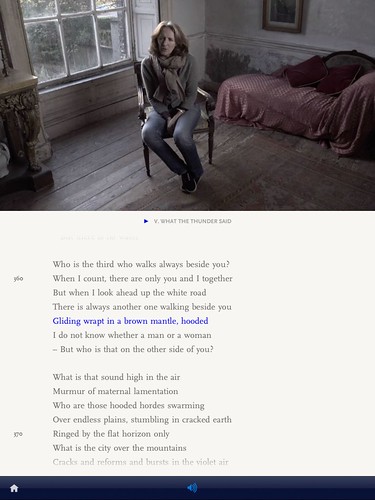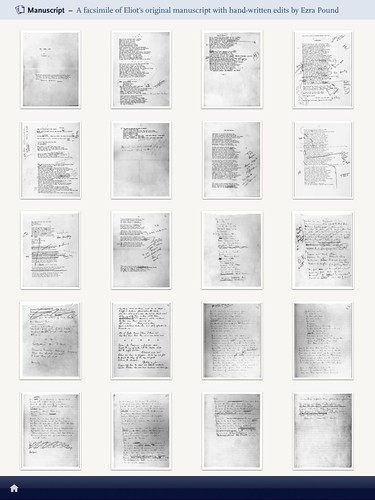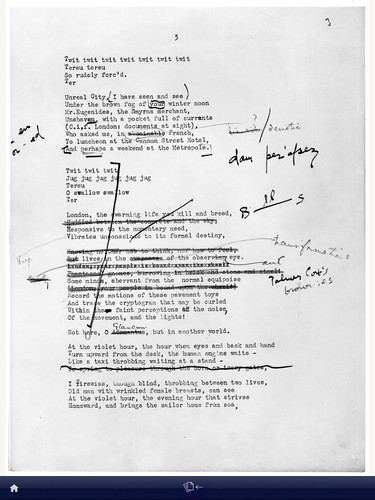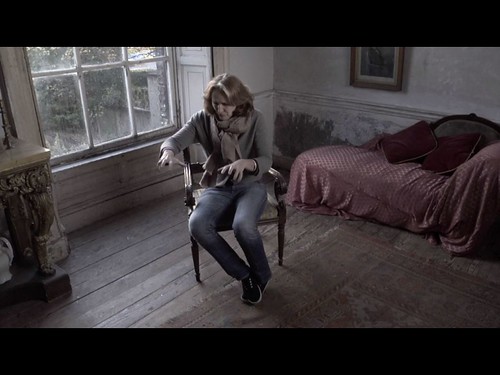 Whither publishing today, in this era of e-books and apps, and whither especially poetry publishing, which faces its own set of genre-specific issues? As Reggie H. (naturally) alerted me this morning by sending along the Guardian UK I cite below, the venerable British publishing firm Faber & Faber, in conjunction with Touch Press, an app development/publishing company, suggests through its extraordinary new offering one likely direction for the future, with its Waste Land app. I kid not.
Whither publishing today, in this era of e-books and apps, and whither especially poetry publishing, which faces its own set of genre-specific issues? As Reggie H. (naturally) alerted me this morning by sending along the Guardian UK I cite below, the venerable British publishing firm Faber & Faber, in conjunction with Touch Press, an app development/publishing company, suggests through its extraordinary new offering one likely direction for the future, with its Waste Land app. I kid not.Touch Press takes one of the landmark works of 20th century Anglo-American and world literature, T. S. Eliot's (1880-1964) 1922 long poem, The Waste Land, and, using apps' multiple electronic and digital resources and the iPad's display capabilities, brings Eliot's poem to life in a strikingly refreshing and enthralling way. It's no gimmick, I assure you. Here's the Guardian UK's video report on it, which describes how the app came about.
Not long after Reggie sent me the link to the Guardian piece, I came across Laura Miller's Slate article on the new app, "The Waste Land": T.S. Eliot takes the app store," which walks readers through the app and argues that it represents the best example of how to make a "digital book." So what does the app comprise?
You get, in very easy-to-navigate format
- The poem, in full published text version, laid out as it would be in codex book form;
- The poem, read by Eliot himself, in 2 different versions (1931, 1947), as well as by Alec Guinness, Ted Hughes, Viggo Mortenson (?), and the remarkable Irish performer Fiona Shaw;
- The poem performed by Fiona Shaw, in a Dublin house--I have watched this several times now, and I don't think I've ever heard Eliot's language enlivened, embodied, like this;
- Videotaped perspectives, by Seamus Heaney (who needs no intro), Paul Keegan (Poetry Editor at Faber & Faber since 1999), Jim McCue (a leading Eliot expert and publisher), Craig Raine (the poet and critic), Fiona Shaw, Frank Turner (a musician heavily influenced by Eliot), and Jeanette Winterson (the fiction writer and critic), which play alongside selected sections of The Waste Land;
- A facsimile of Eliot's original manuscript, edited by Ezra Pound, which you can view page by page, or, by sliding the screen in one direction, interspersed with the final version;
- Annotations and other notes explicating the text, in addition to the ones Eliot (in)famous provided;
- A gallery of photographs and images linked directly or indirectly to the text; these range from a photo of Eliot's native Saint Louis in the early 20th century to Pablo Picasso's Les demoiselles d'Avignon to a photo of Vivien Eliot, the writer's tragic first wife, to two (why?) photos of Bob Dylan (one would have sufficed).
 |
| Eliot, Corbis |
As I mentioned to Reggie, after watching the Guardian piece and reading Miller's report, I had to purchase the app, which is $15 (not cheap, of course, especially given the usual app range of .99-$10), and I'm glad I did. Here are some screenshots of it.

A screenshot of the facsimile pages

A screenshot of one of the most famous of Pound's emended pages of Eliot's text (note the "B_ll_s")

A screenshot of Shaw performing alongside the scrolling text (the lines she speaks and performs automatically highlight in blue)

A screenshot of the app with the notes/annotations at left

A screenshot of Fiona Shaw performing the poem
This is not the first time someone has adapted The Waste Land for new technologies. An older example is this hyperlinked version, which would have been pretty advanced 15 years ago, and which still represents a heightened and very useful option for exploring Eliot's poem. My own introduction to The Waste Land after high school--and I admit to having been somewhat obsessed with Eliot as a teenager--came in my freshman year, when I conned my way into Joel Porte's "American Modernist Thought," most of which went over my head, at least the theoretical parts, but I do vividly remember the marvelous facsimile version of The Waste Land that we read, and I was shocked by all of Pound's excisions. He was, as Eliot rightly noted, at least in this effort, il miglior fabbro, the dedication he added in 1925. I will be returning to this app again and again, I think, and hope that other publishers, along with Touch, keep producing works of this sort.
It just might get more people reading and thinking about not just poetry, but literature and the arts and humanities in general.









No comments:
Post a Comment